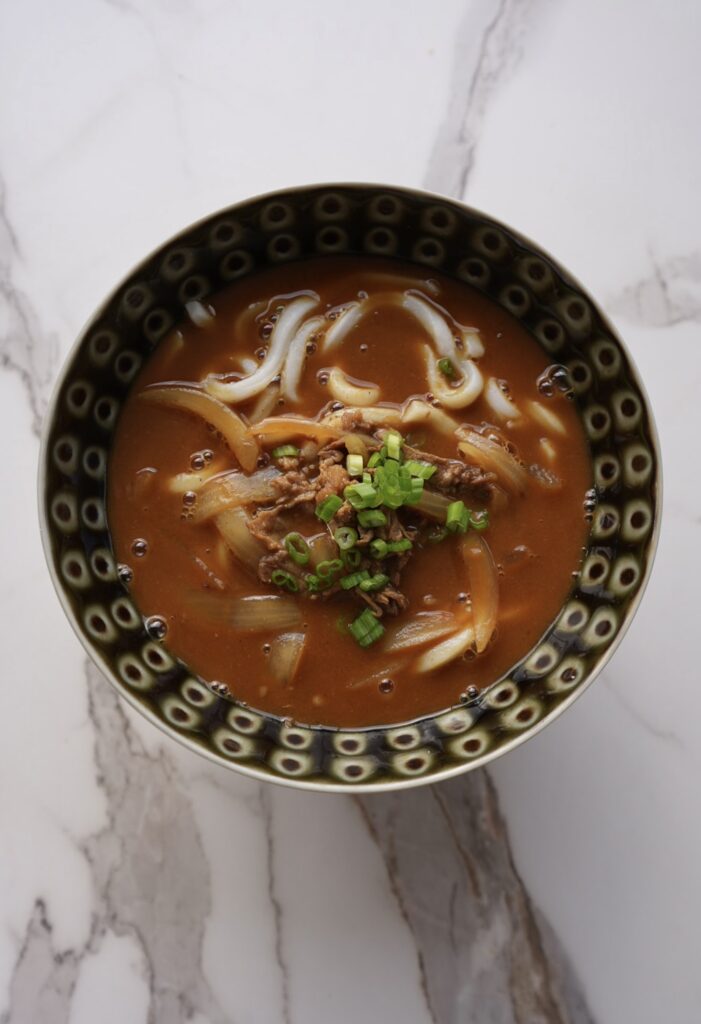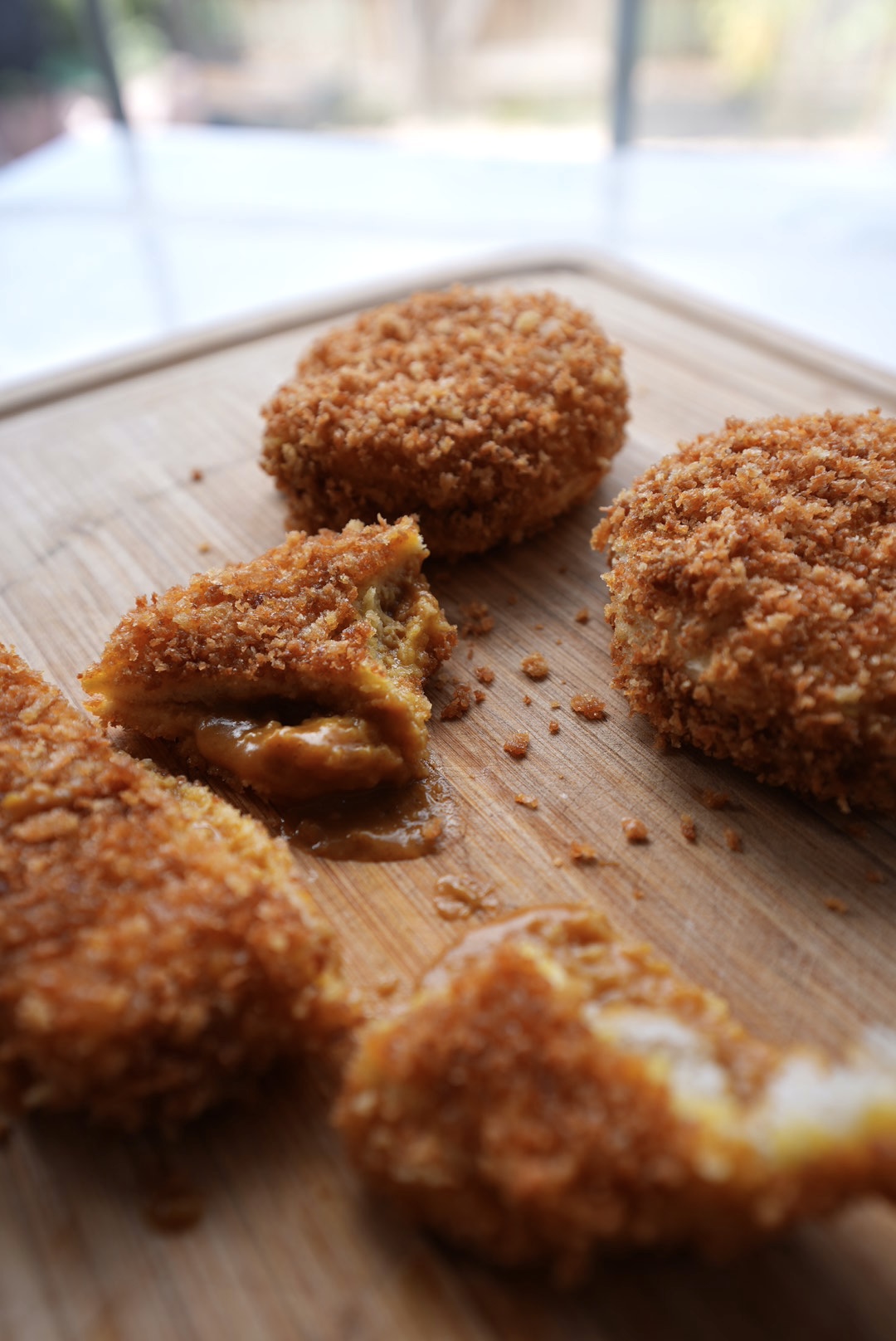Curry udon is one of those heartwarming dishes that feels especially satisfying when enjoyed in Japan, particularly in those small, cozy eateries that seem tucked away from the bustling city streets. There’s something special about walking into a hole-in-the-wall shop, where you’re often greeted by the delicious aroma of curry and udon noodles simmering.
The dish itself is simple yet comforting – a bowl of thick, chewy udon noodles nestled in a rich, savory curry broth that’s seasoned with Japanese curry roux. Japanese curry is mild, slightly sweet, and hearty, so it perfectly coats the udon noodles.
Each shop often has its unique twist on the dish, whether it’s the specific blend of curry spices, the thickness of the broth, or additional toppings like green onions, thinly sliced beef, or a sprinkle of togarashi (Japanese chili flakes).

How to Make Curry Udon
- In a pot, sauté your preferred veggies & protein.
- Pour in dashi and add Japanese curry roux cubes and stir until dissolved, creating a thick, flavorful curry broth.
- While that simmers, cook udon noodles according to package instructions.
- Add the cooked udon, stirring to coat them in the curry broth. Let them simmer briefly to absorb the flavors.
- Serve hot, garnished with sliced green onions, togarashi (chili flakes), or a sprinkle of sesame seeds.

How to Make Dashi: Japanese Cooking Stock
Dashi is an essential ingredient in Curry Udon. It’s a light Japanese broth made from ingredients like kombu (dried kelp) and katsuobushi (dried bonito flakes), forming the savory, umami-rich base for many Japanese soups and sauces.
Here are 3 different ways to make it:
1. Dashi from Scratch: Traditional dashi, made by simmering kombu (dried kelp) and katsuobushi (dried bonito flakes), is considered the best method. Soak the kombu in water, heat just below boiling, and add katsuobushi. This method is ideal for dishes with the purest flavor.
2. Dashi Packets (pictured): Dashi packets, resembling tea bags, contain dried kombu, katsuobushi, and sometimes shiitake mushrooms or dried sardines. Just simmer the packet in water for a few minutes for a quick and flavorful broth.

I love these dashi packets from Kayanoya.
3. Instant Dashi (Hondashi): Instant dashi, often called hondashi, is a granulated or powdered form of dashi. Just a spoonful dissolved in hot water creates a quick and flavorful stock.
This option is convenient and ideal for busy days. I recommend instant dashi as the easiest experience for beginners.

I use this instant dashi from Ajinomoto most frequently.
How to Make Japanese Curry at Home
Japanese Curry Udon combines two beloved comfort foods—curry and udon noodles—into one bowl of deliciousness.
To make the base of Japanese curry, you will need Japanese curry roux. It’s a concentrated curry base made by cooking flour, oil or butter, and Japanese curry spices into a thick paste, often sold in block or cube form. When added to simmering meat and vegetables, it melts into a rich, savory, slightly sweet curry sauce that’s a staple in Japanese home cooking.
I recommend using curry roux from:
- Java Curry (pictured; the one I like the most because I think it is the spiciest!)
- S&B Golden Curry
- Vermont Curry (best for those who like curry on the sweeter side).

Check out my other recipes that use Japanese curry!:
About Udon Noodles
Udon noodles are thick, chewy Japanese wheat noodles known for their hearty textue and versatility. They are traditionally served in hot soups, stir-fries, or cold dishes, and come in three main forms:
- Fresh Udon: Chewy, bouncy texture, often found in the refrigerated section of Asian grocery stores. These noodles cook quickly and absorb flavors well.
- Frozen Udon: Great alternative to fresh, as it retains much of the same chewy texture (pictured).
- Dried Udon: Firmer, less chewy texture compared to fresh or frozen versions. I personally stray from purchasing dried udon and stick with fresh or frozen.

Curry Udon
- Total Time: 15 minutes
Description
Japanese curry udon is a comforting dish of thick, chewy udon noodles served in a rich, savory curry broth, often accompanied by tender meat and vegetables, making it a hearty and flavorful meal.
If you love Japanese curry, check out my other recipes that use it:
Ingredients
- 3–4 cups dashi (alternatively, you can use 3-4 cups water with 2 teaspoons of hondashi)
- 1 tablespoon soy sauce
- 1 teaspoon mirin
- 2 cubes Japanese curry roux
- 1/2 yellow onion, thinly sliced
- 1/2 lb thinly sliced beef
- 2 servings udon noodles (I recommend using frozen udon noodles. You can find them at most Asian markets)
- Optional Garnish: Green onions and togarashi (Japanese chili spice)
Instructions
- In a large pot, combine 3-4 cups of dashi, soy sauce, and mirin (add more or less dashi depending on how thin or thick you want your broth to be). Stir to combine and bring to a simmer over medium heat.
- Add the thinly sliced onion to the pot and simmer for 3-4 minutes until the onion softens.
- Add the thinly sliced beef to the pot and cook until it is almost completely cooked.
- Break the curry roux cubes into pieces and add them to the pot. Stir until the roux is fully dissolved and the broth thickens, creating a rich curry sauce.
- While the curry is simmering, cook the udon noodles according to the package instructions (typically by boiling them in water for a few minutes). Once cooked, drain and set aside.
- Add the cooked udon noodles into the curry broth and serve the curry udon hot, garnished with additional toppings like green onions and togarashi if desired.
- Prep Time: 5 minutes
- Cook Time: 10 minutes
Nutrition
- Serving Size: 2











It turned out well! Great way to eat curry if you’re in the mood.
Hi Christian! I agree – glad you loved it! 🙂